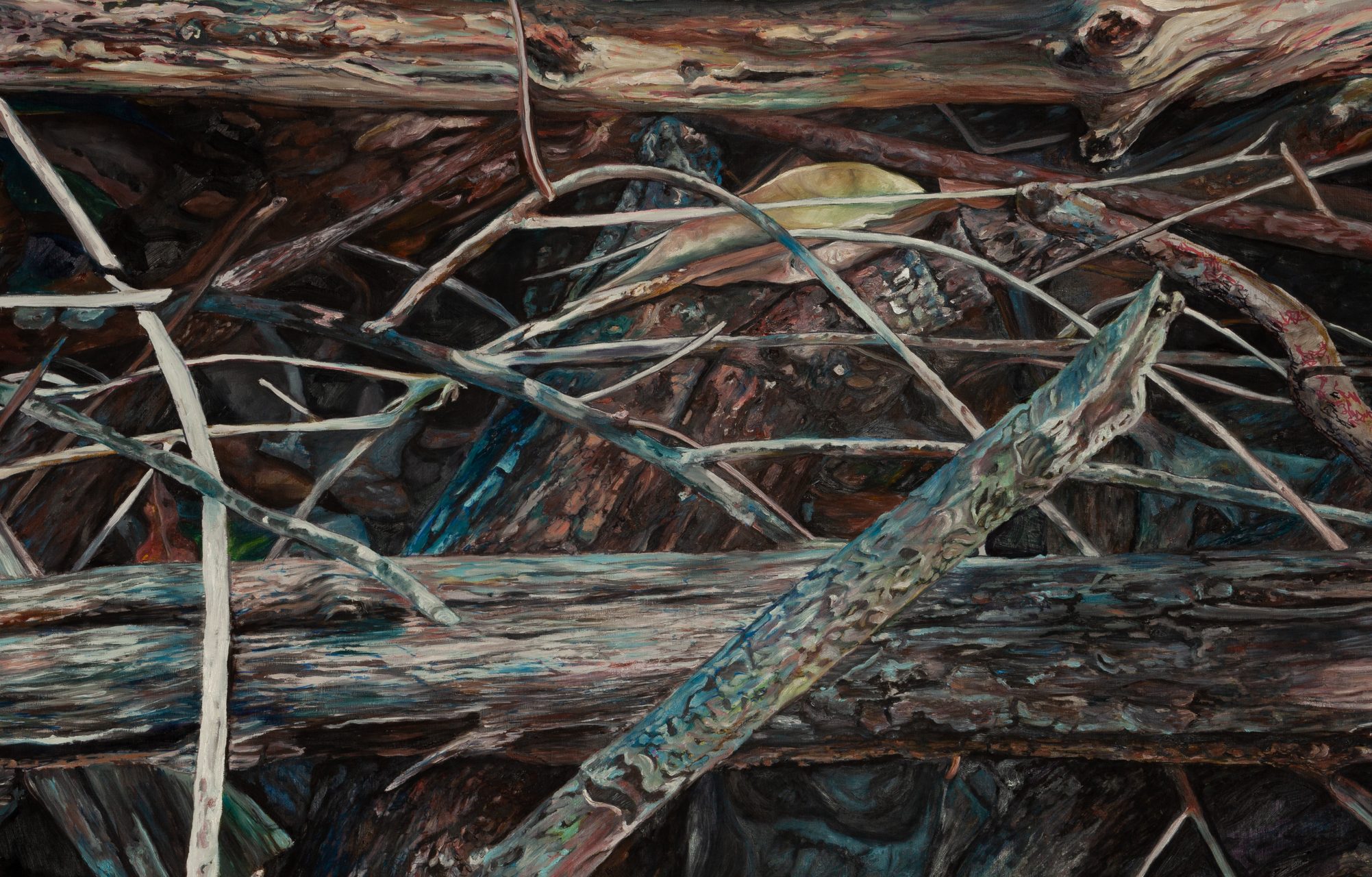Based on a true story
Nicola Rotiroti
19 Jan 2023 - 18 Feb 2023
Vernissage
Thursday 19 Jan 2023 | 18:00-21:30
Location
Kou Gallery - Via della Barchetta, 13 - 00186 Roma
Critics
Massimo Scaringella
Ludovica Palmieri
Roberto Gramiccia
Artist profile
Nicola Rotiroti
View at 360°
Works
Nicola Rotiroti
Works
CURATED BY LUDOVICA PALMIERI
Seven works. Large, heavy, physical. Daughters of a hand-to-hand struggle of the artist with the canvases. Suffered works, born from the observation of reality, from a "true story" precisely. Yet in their being, they open to another, parallel dimension. Far from the concreteness and conventions of reality.
The starting point is a pile of twigs, now dried up, noticed by the painter in his yard, "a domestic nature," to use his words. In reality, there is very little of nature-the twigs, if anything, are a reminder of it. A still life that, thanks to Nicola Rotiroti's artistic gesture, not only comes back to life but becomes the protagonist, immanent and preponderant, to the point of occupying the entire space of the canvases, as if to encompass the human element.
Nicola Rotiroti's nature has, therefore, very little that is "natural," even less than domestic. It is inhospitable, psychedelic and threatening. The chromatic range, acidic and cold colors, with a palette reminiscent of Mannerist altarpieces more by Pontormo than Rosso Fiorentino, seems to build a barrier, precluding the viewer's gaze and entry. Next. The void.
As the eye glides over the canvas, to explore all its nooks and crannies, suddenly gaps open up. Empty spaces, like chasms or passages. Entrances to another dimension that create, a sense of vertigo and disorientation in the viewer. Impossible not to think of the magical black hole that took Alice to Wonderland. Although here the discourse is different because, the unnatural emptiness that opens in the painting, refers to a digital reality rather than a natural one. And this hypothesis is confirmed by a statement of the artist who, to describe these pauses in the pictorial fabric, speaks of "Induced emptiness. As if all human beings were simultaneously dazzled, then preserving on the retina the memory of that light so strong that the rest disappeared."
This element of suspension of the pictorial fabric that is present, like a constant, in all the works, gradually expands until it becomes preponderant in Migrante, one of the black and white works.
In the color works, which were made earlier, initially "the void" appears tentatively, and then becomes more and more pronounced. And, since emptiness, it is known, does not exist in nature, even for Nicola Rotiroti the emptiness does not correspond to the canvas left in its prepared state: an acrylic gray obtained through the mixing of different colors, but to a surface applied over the canvas, with the technique of collage that amplifies and thickens this dimension of emptiness. As if it becomes a sounding board of the work itself; a short circuit in the pictorial texture that, indeed, refers to something else. Here, this something else for the artist is the virtual world, the Metaverse, which he, little akin to technology, has struggled to accept and, therefore, perceives as a threat to the human and, in particular, to that contemplative state that is typical of human beings.
The seven works in "Taken from a True Story" can also be read, therefore, as a critique of the Metaverse, understood as a metaphor for innovation at all costs, as a quest for progress at the expense of humanity. The works of Nicola Rotiroti, an artist who by his own admission has struggled greatly to adapt to the "technological revolution," beyond appearance, have nothing digital about them and are the result of an entirely analog, slow, manual work. Made of preparatory studies, trial and error, second thoughts and reflections; of oil paints that take longer to dry and require more patience and awareness.
And if, as a whole, the exhibition opens the door to a parallel, virtual reality, in which everyone can find their own references; the titles of the works, seemingly incomprehensible and totally disconnected from the context, open a window to the artist's unconscious world, whose calmness in the work contrasts with the incessant, frenetic movement of his thoughts that, in the phase of artistic creation, are focused or, better said, condensed in the form of key words that, obsessively, like a mantra, accompany him until the work is finished. These words arise in the painter's mind quite randomly from speeches, songs or readings addressed in relation of physical or conceptual proximity to the work itself.
"Phrases that come back to him hammeringly, continuously, incessantly."
It goes from the first, in order of completion bearing the subtitle "Never Peace" to "Paolo Uccello" to the third "Half-tones are missing." The last colored painting takes its name from an old Neapolitan neo-melodic song by Nino D'Angelo "Pop-corn and chips," while the black and white works are called "Migrante" one and "Staedtler 2" and "Staedtler 3" the other two, which take their titles from the brand of markers used by the artist to make the three monochrome works. "Migrant" is the only work that, in addition to depicting emptiness, leaves ample space for what in my view might be a horizon. The space of the canvas that, I want to imagine, represents hope or, at the very least, a chance to write the future differently.
Ludovica Palmieri

